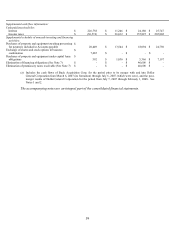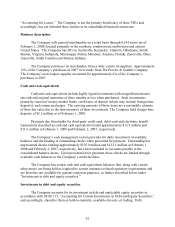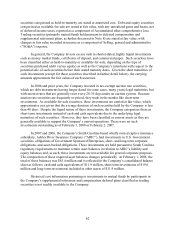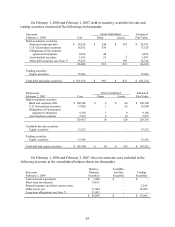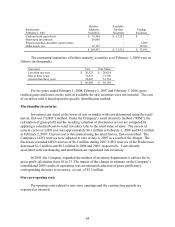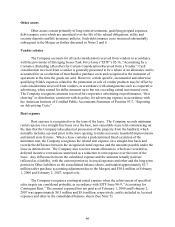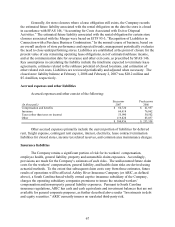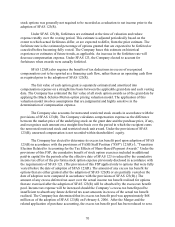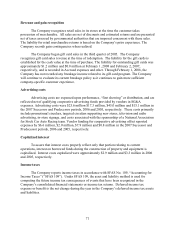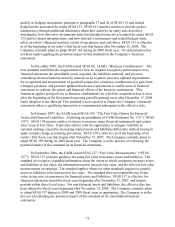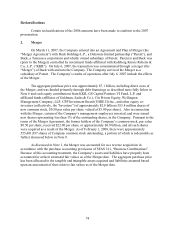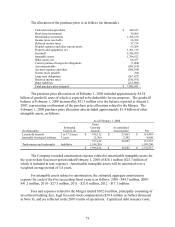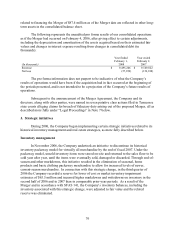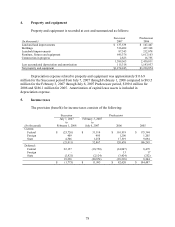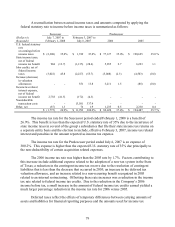Dollar General 2007 Annual Report Download - page 71
Download and view the complete annual report
Please find page 71 of the 2007 Dollar General annual report below. You can navigate through the pages in the report by either clicking on the pages listed below, or by using the keyword search tool below to find specific information within the annual report.69
instrument positions taken by the Company are intended to be used to reduce risk by hedging an
underlying economic exposure.
The Company’ s derivative financial instruments, in the form of interest rate swaps, are
related to variable interest rate risk exposures associated with the Company’ s long-term debt and
were entered into in an attempt to manage that risk. The counterparties to the Company’ s
derivative agreements are all major international financial institutions. The Company continually
monitors its position and the credit ratings of its counterparties and does not anticipate
nonperformance by the counterparties. The Company does not offset fair value amounts of
derivatives and associated cash collateral.
In April 2007, Buck entered into interest rate swaps, contingent upon the completion of
the Merger, on a portion of the loans anticipated to result from the Merger. The interest rate
swaps result in the Company paying a fixed rate of 7.683% on a notional amount of $2.0 billion
as of July 31, 2007, with the notional amount of these swaps amortizing on a quarterly basis
through July 31, 2012. Such notional amount was $1.6 billion as of February 1, 2008. The swaps
were designated as cash flow hedges on October 12, 2007. For the period prior to hedge
designation, an unrealized loss of $3.7 million for the Successor period has been recognized in
Loss on interest rate swaps in the consolidated statements of operations, reflecting the changes in
fair value of the swaps prior to their designation as qualifying cash flow hedging relationships,
which were offset by earnings under the contractual provisions of the swaps of $1.7 million
during the same time period.
As of February 1, 2008, the fair value of the interest rate swaps of ($82.3) million was
recorded in non-current Other liabilities on the consolidated balance sheet. From the date the
swaps were designated as hedges, the effective portion of the change in fair value of the swaps of
($78.6) million was recorded in Other comprehensive income, a separate component of equity,
offset by related income taxes of $29.5 million. The Company also recorded expense related to
hedge ineffectiveness of $0.4 million during the Successor period ended February 1, 2008.
Share-based payments
Effective February 4, 2006, the Company adopted SFAS 123 (Revised 2004) “Share
Based Payment” (“SFAS 123(R)”) and began recognizing compensation expense for share-based
compensation based on the fair value of the awards on the grant date. SFAS 123(R) requires
share-based compensation expense recognized since February 4, 2006 to be based on: (a) grant
date fair value estimated in accordance with the original provisions of SFAS 123, “Accounting
for Stock-Based Compensation,” for unvested options granted prior to the adoption date and (b)
grant date fair value estimated in accordance with the provisions of SFAS 123(R) for unvested
options granted after the adoption date. The Company adopted SFAS 123(R) under the modified-
prospective-transition method and, therefore, results from prior periods have not been restated.
Prior to February 4, 2006, the Company accounted for share-based payments using the
intrinsic-value-based recognition method prescribed by Accounting Principles Board Opinion 25,
“Accounting for Stock Issued to Employees” (“APB 25”), and provided pro forma disclosures as
permitted under SFAS 123. Because options were granted at an exercise price equal to the
market price of the underlying common stock on the grant date, compensation cost related to


